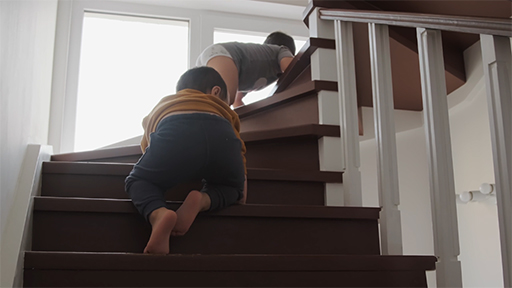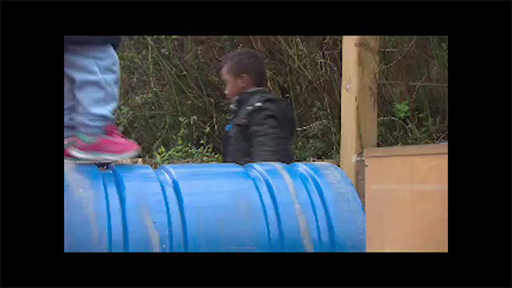3 Risk and challenge
One of the challenges faced when providing play and movement opportunities for babies and toddlers is how to manage risks. If babies didn’t take risk, they would never learn to navigate the world through rolling, crawling, standing, taking their first steps and running, so we need to introduce risk and allow them to learn from mistakes so they can develop these skills. Accidents are part of the learning that children need to undertake, and it is our job to be alert to potential hazards and balance these against the learning opportunities to minimise the risks.
Activity 12.1 Activity 3 Risky play
This video shows an example of risky play. As you watch it, notice how you feel as the boys crawl down the staircase. Are there times when you might say something or intervene? Please note: the video has no audio and plays at slow speed.

Now watch this Open University video to see how risky play is managed in a nursery and a forest school setting.

Transcript: Video 4
Comment
In the video you saw how the practitioners used their knowledge of each child to decide what level of support or encouragement they needed. Some children needed to hold Fernando’s hand to face the challenge of balancing on the equipment, but with other children, he knew they could cope as he increased the challenge by moving equipment to create gaps for them to jump over. These examples show us the important role practitioners play in enabling children to take risks and to learn from those experiences.
The examples above show the important role practitioners play in enabling children to take risks and to learn from those experiences. How can risky play be supported?:
- Observation is key to this, and the willingness to encourage babies and toddlers to participate in risky play. Practitioners need to lead the way in order to provide children with the encouragement and resilience to persist and create their own challenge.
- Providing plenty of opportunities for children to experiment and explore risk throughout the day, both inside and outdoors. Plan the environment and set up with irresistible invitations to play and take risk, then stand back and observe.
- Respond sensitively to requests for help, don’t jump in too soon, practitioners may need to encourage that persistence and ‘I can do’ attitude, especially for children who have little experience of risk.
- Using positive vocabulary and scaffold actions with the language. Stringing actions to form sequences is similar to linking words to form sentences, and when children demonstrate meanings of words physically, their understanding of the words is more immediate and longer lasting. For example, action words such as crawl and slither.
- Practitioners should try not to be too overprotective with the children in their care, as this creates tension between ensuring safety and allowing for risk. It can lead to an underuse of materials, which leads to boredom.
- Practitioners can be champions for supporting balanced risk opportunities, by helping parents and other adults to understand why it is important. Babies and toddlers soon become aware of the capabilities and limitations of their own bodies.
- Let children find out things for themselves through trial and error. It is also important to recognise that every child follows a unique inner timetable and skills are acquired when they are ready.
Risky play is a great example of how the ‘enabling adults’, ‘engaging experiences’ and ‘effective environments’ that underpin the Welsh Government’s A Curriculum for Funded Non-maintained Nursery Settings (2022) and their Framework for Early Childhood Play, Learning and Care (2023) overlap to help support babies and toddlers to develop and progress.

